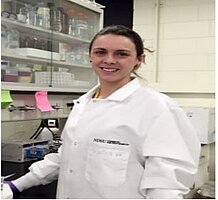Endoxifen in Wastewater and Surface Water in North Dakota: Detection and Biodegradation

Martina Martin
Fellow: Marina Arino Martin
Adviser(s): Eakalak Khan and John McEvoy
Photodegardation of (E)-and (Z)-endoxifen in Wastewater Treatment Plants at North Dakota: Kinetics, By-products Identification and Toxicity Assessment
Cancer cases worldwide are expected to increase by 57% during the next 20 years, and during the last decade the number of people with breast cancer has dramatically increased around the world. North Dakota is no exception to the trend. A statistical study published by the North Dakota Statewide Cancer Registry revealed that breast cancer was a major cancer type in North Dakota from 2008 to 2012. Among different breast cancer types, positive endocrine (ER+) breast cancer accounts for 60-70 % of all cases. Patients with ER+ breast cancer commonly receive selective estrogen receptor modulators (SERMs) as an anti-cancer therapy.
In the United States, for the last 40 years, tamoxifen has been prescribed as a long-term treatment SERM to treat ER+ breast cancer and as a preventive treatment for women with a high-risk of breast cancer. Oncological hospitals in North Dakota, such as Sanford Medical Center in Fargo, also administer tamoxifen as chemotherapy treatment in 99.3% of the cases. The effectiveness of tamoxifen relies on an ability of the liver to actively metabolize the drug to endoxifen. However, endoxifen is not completely metabolized in human body and is actively excreted. As a result, endoxifen is released to the water environment via wastewater treatment plants (WWTPs). The presence of endoxifen in the environment could bring negative effects to aquatic lives. This research investigated the use of ultraviolet radiation (253.7 nm) and natural sunlight to photodegrade endoxifen in water and wastewater, and the generation of photodegradation by-products (PBPs) and their toxicity. The concentration of endoxifen in water was reduced by 99.1% after 35 seconds of UV light radiation generating two highly toxic PBPs. Photodegradation of endoxifen in wastewater at UV light doses used for disinfection resulted in reduction of endoxifen by 30 to 71%. Endoxifen concentration in wastewater was reduced by at least 83% after 150 minutes of solar radiation generating eight PBPs. Seven of these PBPs are potentially more toxic than endoxifen itself. Therefore, highly toxic PBPs are potentially generated at WWTPs if endoxifen is present in the wastewater.
Significance of Research
The research results elucidate the abilities of UV light (253.7 nm) and sunlight to degrade (E)- and (Z)-endoxifen in wastewater collected from Moorhead WWTP. Identification of potential (E)- and (Z)-endoxifen by-products and the estimation of their toxicity in the aquatic environment demonstrate the suitability of UV light (253.7 nm) and sunlight as (E)- and (Z)-endoxifen treatment processes. An effective treatment technique for (E)- and (Z)- endoxifen would be useful in reducing their release to the aquatic environment in North Dakota and in turn potential toxicological effects on aquatic lives or even humans. Identification of the acute toxicity of (E)- and (Z)-endoxifen in water lead to a better understanding of the potential environmental effect that endoxifen could cause. In addition, elucidating the fate of (E)- and (Z)-endoxifen in wastewater and receiving surface water lead to a better understanding on potential sources of the compounds and their PBPs in the aquatic environment of North Dakota.
Significant Findings
Photodegradation process based on monochromatic UV light irradiation at 253.7 nm is an efficient process for removing (E)- and (Z)-endoxifen from water. The irradiation resulted in ≥ 99.1% elimination of (E)- and (Z)-endoxifen at a light dose of 513 mJ/cm2 . In addition, the irradiation of (E)-and (Z)-endoxifen with UV light at 244 W cm-1 s -1 for 120 minutes resulted in mineralization of endoxifen in water at 73.4%.
Natural sunlight also photodegraded endoxifen in water. An effective elimination of (E)-and (Z)-endoxifen in water was observed after 180 minutes of solar radiation reducing the concentration by 90 and 93%, respectively.
Although UV and natural sunlight photodegradation is a promising process for degrading (E)- and (Z)-endoxifen in water, seven PBPs, potentially more toxic than (E)- and (Z)- endoxifen, were observed along the photodegradation time course. The presence of these PBPs in the water environment could bring negative effects to aquatic lives.
Presentations:
Poster Presentation at North Dakota Water and Pollution Control Conference (First Price on Poster Presentation)
Oral Presentation at the Institute of Technology-GRDS

Eakalak Khan
Civil & Environmental Engineering
NDSU

John McEvoy
AES Microbiological Sciences
Office: VanEs 132A
Telephone: 701-231-8530
Email: john.mcevoy@ndsu.edu


